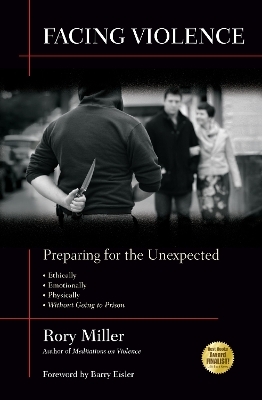
Facing Violence
Preparing for the Unexpected
Seiten
2011
|
New edition
YMAA Publication Center (Verlag)
978-1-59439-213-9 (ISBN)
YMAA Publication Center (Verlag)
978-1-59439-213-9 (ISBN)
Provides an introduction to the context of self-defense. It includes seven elements that must be addressed to bring self-defense training to something approaching 'complete.'
Gold Winner - 2012 eLit AwardFinalist - 2012 USA Best Books AwardHonorable Mention - 2012 Eric Hoffer Award Seven Steps to Legal, Emotional and Physical Preparation This book stands alone as an introduction to the context of self-defense. There are seven elements that must be addressed to bring self-defense training to something approaching 'complete.' Any training that dismisses any of these areas leaves you vulnerable. 1. Legal and ethical implications. A student learning self-defense must learn force law. Otherwise it is possible to train to go to prison. Side by side with the legal rules, every student must explore his or her own ethical limitations. Most do not really know where this ethical line lies within them. 2. Violence dynamics. Self-defense must teach how attacks happen. Students must be able to recognize an attack before it happens and know what kind they are facing. 3. Avoidance. Students need to learn and practice not fighting. Learning includes escape and evasion, verbal de-escalation, and also pure-not-be there avoidance. 4. Counter-ambush.
If the student didn't see the precursors or couldn't successfully avoid the encounter he or she will need a handful of actions trained to reflex level for a sudden violent attack. 5. Breaking the freeze. Freezing is almost universal in a sudden attack. Students must learn to recognize a freeze and break out of one. 6. The fight itself. Most martial arts and self-defense instructors concentrate their time right here. What is taught just needs to be in line with how violence happens in the world. 7. The aftermath. There are potential legal, psychological, and medical effects of engaging in violence no matter how justified. Advanced preparation is critical. Any teacher or student of self-defense, anyone interested in self-defense, and any person who desires a deeper understanding of violence needs to read this book.
Gold Winner - 2012 eLit AwardFinalist - 2012 USA Best Books AwardHonorable Mention - 2012 Eric Hoffer Award Seven Steps to Legal, Emotional and Physical Preparation This book stands alone as an introduction to the context of self-defense. There are seven elements that must be addressed to bring self-defense training to something approaching 'complete.' Any training that dismisses any of these areas leaves you vulnerable. 1. Legal and ethical implications. A student learning self-defense must learn force law. Otherwise it is possible to train to go to prison. Side by side with the legal rules, every student must explore his or her own ethical limitations. Most do not really know where this ethical line lies within them. 2. Violence dynamics. Self-defense must teach how attacks happen. Students must be able to recognize an attack before it happens and know what kind they are facing. 3. Avoidance. Students need to learn and practice not fighting. Learning includes escape and evasion, verbal de-escalation, and also pure-not-be there avoidance. 4. Counter-ambush.
If the student didn't see the precursors or couldn't successfully avoid the encounter he or she will need a handful of actions trained to reflex level for a sudden violent attack. 5. Breaking the freeze. Freezing is almost universal in a sudden attack. Students must learn to recognize a freeze and break out of one. 6. The fight itself. Most martial arts and self-defense instructors concentrate their time right here. What is taught just needs to be in line with how violence happens in the world. 7. The aftermath. There are potential legal, psychological, and medical effects of engaging in violence no matter how justified. Advanced preparation is critical. Any teacher or student of self-defense, anyone interested in self-defense, and any person who desires a deeper understanding of violence needs to read this book.
Rory Miller, former Sergeant, has been studying martial arts since 1981. He's a best-selling writer and a veteran corrections officer. He's taught and designed courses on Use of Force Policy and Decision Making, Police Defensive Tactics, Confrontational Simulations, and he has led and trained his former agency's Corrections Tactical Team. Recently, he taught how to run a modern, safe, and secure prison at the Iraqi Corrections Systems, Iraq. Rory Miller resides near Portland, Oregon.
| Erscheint lt. Verlag | 16.6.2011 |
|---|---|
| Vorwort | Barry Eisler |
| Zusatzinfo | illustrations |
| Verlagsort | Rolindale, MA |
| Sprache | englisch |
| Maße | 152 x 228 mm |
| Gewicht | 372 g |
| Themenwelt | Sachbuch/Ratgeber ► Sport ► Kampfsport / Selbstverteidigung |
| ISBN-10 | 1-59439-213-7 / 1594392137 |
| ISBN-13 | 978-1-59439-213-9 / 9781594392139 |
| Zustand | Neuware |
| Informationen gemäß Produktsicherheitsverordnung (GPSR) | |
| Haben Sie eine Frage zum Produkt? |
Mehr entdecken
aus dem Bereich
aus dem Bereich
vom Weißgurt bis zum 1. Dan
Buch | Softcover (2024)
Palisander Verlag
CHF 41,70
surviving extreme outdoor situations
Buch | Softcover (2024)
Tuttle Publishing (Verlag)
CHF 13,95


